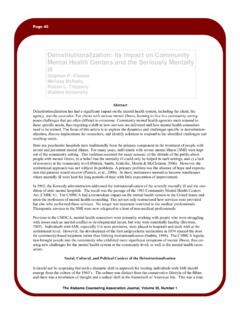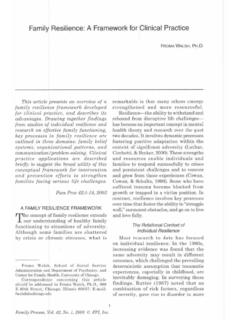Transcription of The Importance of Integrating Reflexes - Move Play Thrive
1 Integrating Reflexes is key for the ability to learn easily, manage our emotions and impulses, and meet life s challenges with greater ease. Incomplete intregration of childhood Reflexes can be mild to severe, and contributes to anxiety; depression; ADD; ADHD; autism; learning disorders; developmental delay; sensory-integration disorders; vision and hearing problems; behavioral challenges ; extreme shyness; lack of confidence; addiction; inefficient, effortful work and constantly feeling Movement helps children and adults complete the Reflexes and transform challenges into is a reflex?
2 A reflex is an automatic, instinctual move-ment that assists in development, growth and survival. Blinking is a reflex. Many Reflexes are active throughout our lives. Other Reflexes called primitive Reflexes surface in the womb and infancy and are designed to become inactive after the toddler stage. Two familiar primitve Reflexes are sucking and grasping with the hand. Ideally, primitive Reflexes merge into more sophisticated move-ments, and become integrated. An integrated childhood reflex is no longer active. What causes unintegrated Reflexes ?Unintegrated, active childhood Reflexes can be caused by:Lack of enough proper movement in early childhood: Plastic carriers, propping devic-es, playpens, walkers, swings, jumpers and car seats all restrict movements required for brain development.
3 TV and computer use also hamper opportunities for of the mother during pregnancy, breech birth, birth trauma, Caesarean or exposure to , trauma, injury, chronic toxins and plastics; com-plications with vaccinations; exposure to electronic pollution. Even Reflexes that are completely integrated may become reactivated later by trauma, injury, toxins and are Reflexes important?From the womb on, the childhood reflex movements literally grow the brain. Repeti-tive, automatic reflex movements are essential for the development of balance, mobility, vision, hearing, speaking, learning and movements are the first founda-tions of the nervous system.
4 Like a block tower, all further development depends on the readiness of the originate in the brain stem, or survival brain. When Reflexes remain active, the survival brain is constantly stimulated. In this survival mode, there is less ability to access the prefrontal lobes, where we think, create, communicate and make beneficial decisions. In other words, we are more likely to react instead of control-ling our impulses. Unintegrated Reflexes trigger the fight or flight response, creating chronic stress. Even when there is no logical reason for stress, we can feel stressed because our physiology is constantly reacting as if threatened.
5 Stress becomes a habit, often below the level of our awareness. When Reflexes are active, body parts cannot easily move independently. A movement of the head causes an auto-matic movement in the limbs, hands or feet. Extra limb movements happen below the surface level and cause confusion in the neuro-sensory-motor system. This confusion creates difficulties with growth, coordination, reading, writing, speaking and child who fidgets in his chair and cannot focus is more than likely suffering from active Reflexes . Once Reflexes are integrated, head and limb muscle groups can move independently, and the ability to sit atten-tively without fidgeting comes easily.
6 Active Reflexes cause aches and muscle tension, weak muscle tone, fatigue and the need for great amounts of effort to complete tasks. We unconsciously learn to compensate for and suppress active Reflexes , which can cause considerable ten-sion and drain energy. Skills that should be automatic (like reading and writing) can be done only with continuous conscious and Play for IntegrationAt any age, we can integrate the Reflexes and rebuild the foundation of our nervous system through Neurodevelopmental Movement. We start by assessing which Reflexes need integration. Then we do a series of age-ap-propriate activities specifically designed for each reflex.
7 Neurodevelopmental Movement is highly effective because it taps into the same system we are designed with at birth for reflex integration and brain development. We add play, because play is fun, healing and transformative. Neurodevelopmental Movement creates quantum shifts and positive changes. Life and learning become much easier once the childhood Reflexes are Movement is beneficial for all ages and skill levels. It is effective for reflex integration, whole-brain learning, optimizing skills, reducing stress, eliminating blocks and opening the heart. Families especially benefit from the harmony and positive changes that grow from doing movement together.
8 The Importance of Integrating Reflexesby Sonia Story Claire Hocking, Educational Kinesiologist & Brain Gym Instructor AustraliaThe Learning Hierarchy[The illustration depicts] the normal hierarchical developmental system, beginning before the birth of the infant and carrying on through adulthood . If the foundations the primitive and postural Reflexes are unstable, weak or have gaps in their development, they will undermine all other levels to some degree. The motor, perception, speech and conceptualisation will also be unstable, and breakdown in any or all of these areas can occur, causing the higher-level functioning areas to also be affected.
9 Although these stages do overlap to a certain extent, if a stage is missed, interfered with or not fully integrated, it can prevent full development of subsequent stages. Unfortunately the child will not grow out of their learning and behaviour problems. The problems may alter and appear to improve as the child learns to compensate in other ways, but the weakness in their system will remain, causing stress on their system. They may also resurface when the child moves to more intensive learning situations, where the demands of higher learning are greater, and the pressure for academic progress is more Ph (03) 5282 5965 Mobile 0419 569 071 2007 11 Sonia Story | Paralysis Reflex FPR emerges in the 5th to 8th week of womb life, and ideally is integrated before birth.
10 FPR is most likely a protective mecha-nism in the face of danger and may help us learn to cope with stress. FPR is a freezing reaction similar to a deer caught in the headlights. There is tightening of the jaw and eye muscles; limb muscles contract and pull in toward the core. The breath is held, and there may be a significant drop in heart rate. Those who study Reflexes do not always agree on what triggers FPR, but in general we can think of the FPR as a response to a perceived threat. If the FPR is not fully integrated at birth, it can cause lifelong challenges related to fear.






